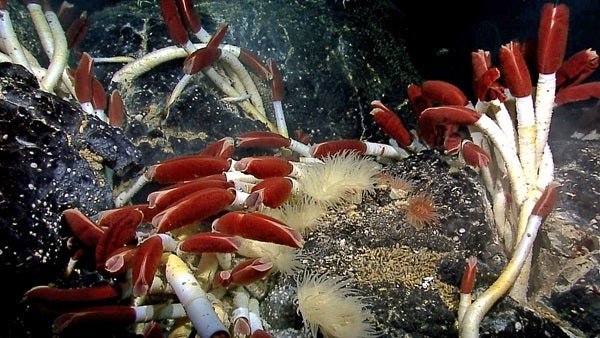It’s no secret that life on other planets may look very different than life on Earth. But could extremophiles—those organisms that live in the most extreme environments on earth, including hydrothermal vents and inside Earth’s crust—provide some clues about the life that we might expect to find in space?
The answer may be yes: such organisms, some scientists say, may help us understand the rich variety of life that we could expect to find elsewhere in space.
“Research that expands our knowledge of the environmental limits of life is indispensable as a strategic element of astrobiological exploration,” said Jack Farmer, Professor of Geobiology at Arizona State University and a participating scientist on the Mars Exploration Rover mission.
One such research study published in Geology provides some intriguing clues as to just what this bacteria could look like. A team of scientists from the University of Cincinnati discovered fossils in two separate locations that appear to be somewhere between 2.5 and 3.5 billion years old, from the Archean Eon. The fossils, found in the Northern Cape Province of South Africa, are the oldest sulfur-oxidizing bacteria (bacteria that are able to derive energy by oxidizing hydrogen sulfide into sulfur) that have thus been found, and likely lived in a deep-water environment containing little to no oxygen.
The bacteria likely lived at a time when the atmosphere on Earth had oxygen levels of less than 1 percent—and less than one-thousandth of one percent of what they are today, according to a press release on the study. While the bacteria are much larger than most modern bacteria, they are similar to some single-celled organisms that live in sulfur-rich parts of the deep ocean today.
“These are some of the largest fossil cells ever found in the Archean Eon,” Andrew Czaja, assistant professor at the University of Cincinnati in the Department of Geology and the first author of the paper, told Astronomy. “Only a couple of other examples of deep marine fossil microorganisms have been reported from any time in the geologic record.”
The study, Czaja added, could help expand the types of environments in which we can find evidence of past life. Czaja said research into extremophiles in general gives scientists confidence that life can exist anywhere where the appropriate building blocks, including a liquid medium (such as water) and a source of energy, exist.
“Every time we find evidence of life in a new type of environment on Earth, we increase our confidence in finding life on another planet,” Czaja told Astronomy.
Another use of extremophile research? Helping scientists figure out where, exactly, to search for life on other planets: Czaja noted that studies like his own could help scientists select a landing site for future space missions.
Farmer agrees: when seeking life on other planets, he told Astronomy, we tend to “follow habitability,” meaning that we seek zones where the basic requirements for life are met, which is informed by our prior knowledge of what the environmental limits of life are.
“When paleontologists go to South Africa and explore for an Archean fossil record, they are essentially going to another planet—the early Earth,” Farmer said. What we learn there then informs our strategies on how we look for life on other planets, especially fossil records on other planets.
One such mission? NASA’s next Mars rover, which NASA will send to space in 2020 in order to search for the biosignatures of life, Farmer said. According to a press release on the mission, the rover will investigate a specific region of Mars that may, at one point in the ancient past, have had favorable conditions for microbial life.
Still, not all scientists are confident that such extremophiles may provide clues about life on other planets. Malcolm Walter, professor of astrobiology at the University of New South Wales in Sydney and the director of the Australian Center for Astrobiology, told Astronomy that information about extremophiles on Earth does not change his own views about the life we might expect to find on other planets.
“It gets very speculative,” Walter said. “We know so little about environments of planets beyond our solar system.” Since, Walter continued, we only have one sample of life—life on Earth—it’s difficult to predict what types of organisms we might encounter in space.
Interestingly, though, Walter noted that in our own solar system, some rocks can get blasted off from one planet and land on another, potentially even carrying microbial life with them.
Thus, it’s possible that the life we find in space may be very similar to our own, if it shares a single source. Additional research and exploration may shed more light on these possibilities.










